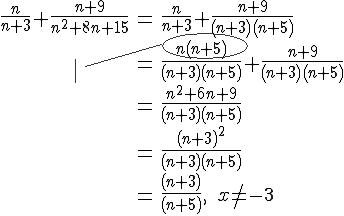__n__......___n+9___
..n+3........n^2 + 8n + 15
4..........__2a__
...............a+1
sorry its the only way i could post that up, in between the 2 fractions on problem number 1 there is a +
and a minus on the second problem... most of my work consists of problems like these but i never learned this in school... im pretty sure i have an answer to #2 but if someone could please run me through the process or simplifying these, it would help so much and i would be able to do the rest of my assignment...
..n+3........n^2 + 8n + 15
4..........__2a__
...............a+1
sorry its the only way i could post that up, in between the 2 fractions on problem number 1 there is a +
and a minus on the second problem... most of my work consists of problems like these but i never learned this in school... im pretty sure i have an answer to #2 but if someone could please run me through the process or simplifying these, it would help so much and i would be able to do the rest of my assignment...

